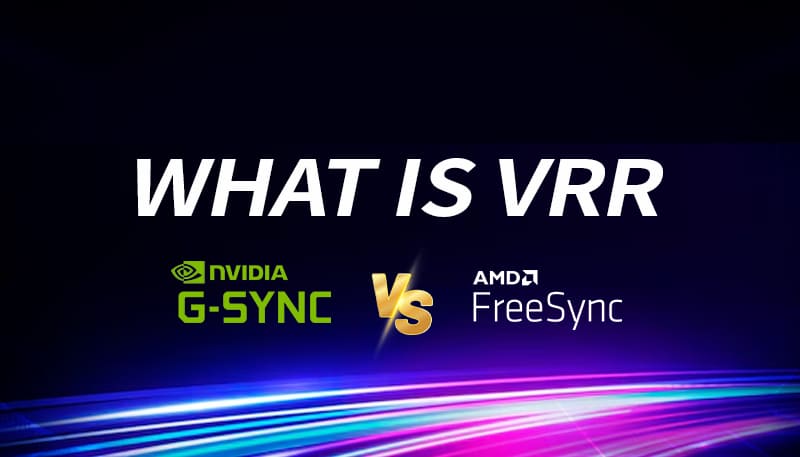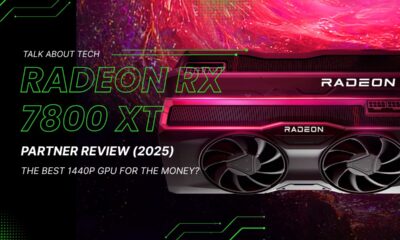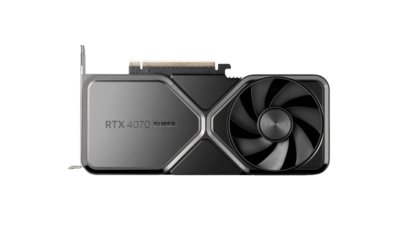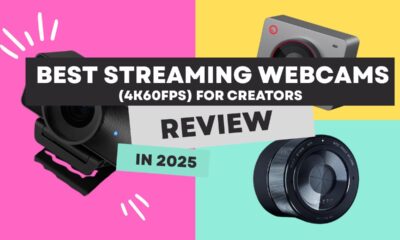Gaming Hardware
VRR Explained: G‑Sync vs FreeSync for Competitive Play
Published
7 hours agoon
By
Samuel Ting
Quick Take: What VRR Does and Why It Matters for Competitive Play
- VRR (variable refresh rate) makes your display refresh when a frame is ready, which removes tearing and greatly reduces stutter while keeping input lag low.
- For PC esports, G‑Sync (module or “Compatible”) and AMD FreeSync (base/Premium/Premium Pro) all work well. Practical differences are features and validation, not blanket latency wins.
- Best-practice setup: enable VRR in your monitor and GPU software, turn on driver V‑Sync as a safety net, and cap FPS ~3 below your max Hz to stay inside the VRR range.
- Buying check: for PC, DisplayPort Adaptive‑Sync; for consoles, HDMI VRR (PS5 only uses HDMI VRR; Xbox works with HDMI VRR and FreeSync).
Quick “Boxed” Settings Recipes (Low‑Latency, Competitive Play)
NVIDIA (GeForce) – 60 seconds
|
AMD (Radeon) – 60 seconds
|
This small buffer keeps your frame rate safely inside the VRR range and prevents hitting the V-Sync ceiling.
🖥️Want a screen that matches your VRR setup? Don’t miss our guide to the Best 27‑Inch 1440p 240Hz Gaming Monitors.
What Is VRR? How Variable Refresh Rate Fixes Tearing and Stutter
Games render frames at irregular intervals. A fixed-refresh display redraws on a metronome (e.g., 240 times per second). When the GPU finishes a new frame mid-scan, two frames share one refresh—this is tearing. Turning on V-Sync hides the tear but forces the GPU to wait for the next refresh. That wait can duplicate frames during dips and adds latency.
VRR (variable refresh rate) lets the display wait for the next completed frame and refresh on demand. The panel’s refresh interval tracks your FPS. The result:
- No tear line (the panel doesn’t cut frames in half).
- Less stutter (no forced duplication from V-Sync).
- Low, consistent latency (no big waits at the end of the pipeline).
Simple Timing Diagram (ASCII – How VRR Removes Tearing)
| GPU renders frames at uneven intervals:
F1—-F2——–F3—F4——F5 |
| Fixed 144 Hz (no VRR)
The display refreshes on a strict timer (every 6.9 ms). |R1|R2|R3|R4|R5|R6|R7|R8|R9| Some refreshes occur mid-frame → partial images (“tears”) or duplicate old frames when FPS drops → stutter. |
| With VRR enabled
The display waits for each finished frame: |R1……..|R2………|R3….|R4…….|R5| Each refresh aligns to a completed frame → no tearing, smoother motion, and consistent latency. |
Result: the display’s refresh rate tracks GPU frame timing instead of forcing the GPU to match a fixed schedule.
A few nuances that matter to competitive players:
- VRR reduces pacing problems, not motion blur. Blur is from pixel response and sample-and-hold; if you want blur reduction, you need a strobe (e.g., ULMB-class tech) — some modern implementations combine strobing with VRR (see “Pulsar” note later).
- Triple buffering with V-Sync can smooth stutter but stores more frames in queue, raising input lag. VRR keeps the queue short.
- Frame-time stability still matters. If the game swings from 220 to 80 FPS, VRR will follow, but you’ll feel those swings. The goal is a stable cap near the top of your VRR range.
VRR Key Terms Explained: LFC, Overdrive, and Refresh Range Made Simple
This section defines the VRR jargon used in the rest of the guide so you can configure your system quickly without guesswork.
- VRR Range – The interval (e.g., 48–240 Hz) over which a display can vary its refresh rate. Wider ranges are better. Some certifications require minimum ratios to assure coverage.
- LFC (Low Framerate Compensation) – When FPS drops below the range floor, the display multiples frames (e.g., 35 FPS → 70 Hz) to keep VRR active and prevent stutter/tearing spikes. Most modern gaming monitors support LFC.
- Overdrive – Extra voltage nudging pixels to change faster. Too strong can overshoot target values, causing inverse ghosting. Variable overdrive adapts the strength as Hz changes.
- Overshoot (Inverse Ghosting) – Bright/dark halos trailing edges due to overdrive going past the target. Tame it by choosing a milder overdrive at your typical FPS/Hz.
G-Sync vs FreeSync: Real-World Differences That Actually Matter
Today’s VRR landscape converges on two brand families:
The G‑Sync Family (NVIDIA)
- G‑Sync (module): Uses a proprietary NVIDIA hardware processor with carefully tuned firmware, offering very wide variable-refresh operation—often extending to extremely low refresh rates depending on the model. NVIDIA recommends choosing displays that can operate from roughly 1 Hz up to their maximum refresh, but actual minimum VRR floors vary between monitors. Typical perks include tight validation, variable overdrive, and access to NVIDIA exclusives like ULMB 2 or Pulsar on supported models; these displays usually cost more.
- G‑Sync Compatible: Adaptive‑Sync displays that NVIDIA validated to work well (no obvious flicker/blanking/artifacts). They must meet certain criteria, including a minimum VRR range ratio (e.g., ≥2.4:1) so VRR stays engaged more often. VRR is enabled by default on GeForce GPUs for these monitors.
- Pulsar (new): A next‑gen G‑Sync tech adding variable‑frequency strobing so you can get VRR and blur reduction together—historically a trade‑off.
The FreeSync Family (AMD)
- FreeSync (base), FreeSync Premium, FreeSync Premium Pro. As you move up tiers you get stricter performance requirements (e.g., LFC; higher refresh at FHD in Premium) and for Premium Pro, an HDR pipeline and certification focused on consistent HDR handling.
Latency Reality Check
Independent testing shows that VRR’s effect on input lag is negligible on modern gaming monitors. RTINGS, for example, noted that VRR “rarely made a difference” in their tests and stopped publishing separate VRR input-lag results. In practical terms, there’s no measurable disadvantage when using VRR versus fixed refresh on the same display. So, don’t pick VRR brand expecting blanket latency wins—choose based on features, validation, price, and your GPU.
Connectivity Notes (PC)
- DisplayPort (DP) Adaptive‑Sync is the open standard VRR path (what FreeSync builds on, and what G‑Sync Compatible supports).
- HDMI VRR is the HDMI Forum’s specification for variable refresh over HDMI 2.1 and newer links. G-SYNC Compatible is primarily a DisplayPort/Adaptive-Sync validation program, but GeForce GPUs also support HDMI VRR on compatible TVs and monitors.
Tip 👉 On many TVs, enabling Game Mode is required for HDMI VRR to engage.
For maximum compatibility, use DisplayPort for PC monitors and HDMI VRR for TVs or consoles.
How to Set Up G-Sync or FreeSync for Low-Latency Competitive Play
-
- Enable VRR on the display
In your monitor’s OSD, toggle Adaptive‑Sync/FreeSync or G‑Sync to On. (Some monitors expose anti‑flicker modes or VRR range options—keep defaults first.)
- Enable VRR on the display
- Cable & port
For PC: use DisplayPort to a VRR‑capable port on the monitor. For a TV or consoles, use HDMI on a port labeled 2.1/VRR. (DP is the most universal path for PC Adaptive‑Sync; HDMI VRR is standardized for TVs/PS5/Xbox.)
- GPU software
- NVIDIA: Enable G-SYNC/G-SYNC Compatible in the NVIDIA Control Panel and use NVIDIA Reflex in supported games. (See the boxed recipe above for detailed V-Sync and FPS-cap settings.)
- AMD: In AMD Software: Adrenalin, ensure FreeSync is Enabled (Display tab). Cap FPS to (max Hz − 3). Optionally use Enhanced Sync instead of driver V‑Sync if you prefer minimal above‑ceiling latency and accept a chance of small tears.
- In‑game
- Turn V‑Sync Off in the game (the driver’s V‑Sync or Enhanced Sync handles the ceiling).
- Pick the right overdrive: usually “Normal/Medium” is cleanest at VRR; avoid the fastest mode if you see halos (overshoot).
- Verify VRR is active
- NVIDIA: enable G‑Sync Indicator overlay in the Control Panel to confirm.
- AMD: Display → FreeSync status shows your tier and whether it’s on.
Understanding VRR Ranges and LFC (and Why the “Hz – 3” Rule Works)
- Every VRR display has a floor and ceiling. Example: 48–240 Hz. Inside that window, the panel paces each refresh to your frame times. If FPS dips below the floor, LFC multiplies frames so the panel can still sync (e.g., 35 FPS → 70 Hz), avoiding tearing/stutter spikes. That’s why you want a wide range and LFC. Most modern gaming monitors have it.
- At the top end, exceeding the ceiling disables VRR for those moments and you’ll fall back to a traditional behavior. With driver V‑Sync On, you avoid tearing but can feel “ceiling hitches.” The fix is simple: limit FPS slightly below max Hz, commonly 3 FPS under, to avoid touching the ceiling while keeping latency low. This recipe is well‑tested for G‑Sync and works similarly with FreeSync.
Overdrive and Overshoot Explained: How Variable Overdrive Improves Motion Clarity
Overdrive speeds pixel transitions. On a fixed‑refresh display you set one overdrive that fits one Hz. But in VRR, Hz is always changing, so a fixed overdrive can be too weak at high Hz (smear) or too strong at low Hz (overshoot). Variable overdrive adjusts strength with the refresh rate; it’s a standout of G‑Sync module monitors and increasingly appears on some Adaptive‑Sync/FreeSync models too (implementation quality varies). Practically, start with Normal/Medium OD and only increase if motion still looks smeary. If you see bright/dark trails, back it down.
Feature Comparison Table: G-Sync vs FreeSync vs FreeSync Premium Pro
Table 1 — Core VRR Features & Validation
| Feature | G-Sync (module) | G-Sync Compatible | FreeSync (base) |
| Connection focus | DP (some HDMI support) | DP for PC VRR; HDMI VRR if display supports | DP / HDMI (varies) |
| Validation | NVIDIA hardware module, strict tuning | Driver validation (≥ 2.4 : 1 VRR range) and VRR enabled by default on GeForce GPUs | AMD-certified base VRR |
| Variable overdrive | ✔ Yes (tuned per Hz) | Varies by model | Varies by model |
| Extras / ecosystem | ULMB 2 / Pulsar / Reflex Analyzer (optional) | Enabled by default on GeForce | Basic VRR only |
Table 2 — Advanced Tiers & HDR Pipeline
| Feature | FreeSync Premium | FreeSync Premium Pro |
| Connection focus | DP / HDMI (Adaptive-Sync standard) | DP / HDMI (Adaptive-Sync + HDR metadata) |
| Validation | AMD Premium spec (LFC + ≥120 Hz @ 1080p) | Adds HDR tone-mapping and latency tests |
| LFC (Low Framerate Compensation) | ✔ Required | ✔ Required |
| HDR Support | Optional / Display dependent | Certified HDR pipeline |
| Typical cost | $ – $$ | $$ |
| Best for | High-refresh competitive monitors | HDR gaming + low-latency color accuracy |
Note: VRR feature names, validation tiers, and certification requirements are determined by NVIDIA and AMD and may differ between monitor models and firmware versions. Performance and latency results can vary depending on panel type, overdrive tuning, VRR range, and GPU drivers. Always verify a monitor’s exact specification and certification status on the manufacturer’s official page or the NVIDIA / AMD registry before purchase.
Buying Guide: G-Sync vs FreeSync Compatibility (PC & Console)
For a PC monitor
- Port: Prefer DisplayPort with Adaptive‑Sync for the broadest PC compatibility; bring HDMI 2.1 VRR primarily for console/TV use.
- VRR range & LFC: Look for a wide range and LFC support. Most current gaming monitors have it.
- Overdrive quality: Reviews should show clean motion without heavy overshoot across the VRR range; variable overdrive is a plus.
- G‑Sync tier or FreeSync tier: Certification helps predict fewer artifacts; G‑Sync module adds some exclusive features (ULMB 2/Pulsar, Reflex Analyzer) but tends to cost more.
- GPU side: GeForce GTX 10‑series+ support Adaptive‑Sync over DP; GTX 16/RTX 20‑series+ add HDMI VRR support too—handy for TVs.
For consoles
- PS5: Uses HDMI VRR. In Settings → Screen and Video → VRR, turn the feature On.
If a game doesn’t list VRR support, toggle “Apply to Unsupported Games” to force HDMI VRR in most titles — this extends VRR benefits to older or unpatched games.
- Xbox Series X|S: Supports HDMI VRR and works with FreeSync displays that expose VRR via HDMI. Many gaming monitors advertise Xbox VRR explicitly. (For detailed PC‑monitor console compatibility, check individual reviews.)
Panel Behaviors (IPS vs VA vs OLED): What to Expect With VRR
IPS
- Generally fast transitions and good consistency across the VRR range.
- Mild overdrive usually looks clean at both low and high Hz.
- Slight glow off-axis is normal; not a VRR issue.
VA
- Strong contrast, but can smear near black at low Hz due to slow dark-to-gray transitions.
- Use a milder overdrive to avoid colored trails.
- Consider capping in the upper-mid range to stay where transitions are faster.
OLED (WOLED/QD-OLED)
- Near-instant pixel transitions; no traditional overdrive.
- VRR flicker can appear in dark scenes at low or swingy FPS; keep FPS stable and near the top of the range.
- Fantastic motion clarity; strobing is rarely needed unless you want CRT-like pursuit sharpness.
⚡ Pair your VRR setup with the right display. Here’s our breakdown of the top-tested 240 Hz monitors for CS2 players in 2025.
Troubleshooting VRR Problems: Fix Flicker, V-Sync Ceiling, and Lag Spikes
OLED VRR flicker (dark-scene pulsing)
- Why: At very low or swingy FPS, refresh intervals vary a lot; OLED gamma and subpixel drive can show brightness pulsation, especially near black.
- Quick fixes:
- Stabilize FPS with a cap and conservative graphics settings.
- Stay in the upper half of your VRR range (e.g., 140–240 on a 240 Hz screen).
- Try display “VRR Anti-Flicker,” “Stabilizer,” or “Limit Range” toggles if available.
- In extreme cases, disable VRR for that title and use a high fixed Hz + a frame cap.
Hitting the V-Sync ceiling
- Symptom: tiny stutters when FPS spikes to the top.
- Fix: Cap Hz − 3 and keep driver V-Sync On (NVIDIA), or V-Sync On / Enhanced Sync (AMD). If still hitchy, try Hz − 5.
Overdrive halos
- Symptom: bright/dark trails following edges.
- Fix: Lower OD one step. If your monitor has variable OD, enable it; if halos persist at low Hz, bias toward a milder OD.
Random black screens / signal drops
- Common cause: marginal cable or port.
- Fix: Use a short, certified cable, reseat connectors, try another port. For HDMI 2.1 at high rates (4K120), reduce to 8-bit or 4:2:2 temporarily to test link stability.
VRR + HDR weirdness
- Symptom: raised blacks, dull highlights, or inconsistent tone mapping.
- Fix:
- Ensure OS HDR is on only when needed.
- Calibrate HDR in-game or via OS tools.
- If your game’s HDR path is unstable with VRR, try SDR for competitive play; SDR is often more consistent and a touch lower latency.
VRR not engaging
- Ensure OSD VRR is On.
- Confirm in driver panels (G-Sync/FreeSync toggles).
- Use overlays to verify.
- Double-check you’re on DisplayPort for PC monitors or HDMI VRR for TVs/consoles.
Console quirks
- PS5: If a title behaves oddly, toggle “Apply to Unsupported Games” off and test.
- Xbox: Make sure 120 Hz is enabled in video options, then toggle VRR.
Can You Use VRR With Backlight Strobing or ULMB? Here’s the Truth
Standard blur‑reduction backlight strobes usually don’t work with VRR at the same time. NVIDIA’s Pulsar is a new approach that synchronizes strobing to variable refresh to keep motion clarity high and avoid VRR artifacts—appearing on select G‑Sync module monitors. If you value maximum clarity for tracking targets, watch for Pulsar‑equipped models.
Which VRR Setup Should You Choose?
- Already on GeForce?
A G‑Sync Compatible (well‑reviewed) or a G‑Sync module monitor both deliver excellent VRR. Module models add extras (ULMB 2/Pulsar, Reflex Analyzer) and more consistent NVIDIA calibration.
- Already on Radeon or mixed devices (PC + consoles)?
A good FreeSync Premium/Premium Pro display with HDMI VRR covers PC over DP and consoles over HDMI in one screen.
- Esports priority: Seek high max Hz, wide VRR range with LFC, clean overdrive (reviews!), and precise FPS limiting. VRR brand matters less than execution.
Settings Recipes by Refresh Tier
Goal: hold latency steady, avoid the ceiling, and keep motion clean. Use these as defaults, then fine-tune per title.
144/165 Hz (entry competitive)
- NVIDIA: G-Sync On, V-Sync On (driver), in-game V-Sync Off, cap 141/162 FPS, Reflex On.
- AMD: FreeSync On, V-Sync On or Enhanced Sync, in-game V-Sync Off, cap 141/162 FPS, consider Anti-Lag+.
240 Hz (mainstream esports)
- NVIDIA: G-Sync On, V-Sync On (driver), cap 237 FPS, Reflex On; OD Normal/Medium.
- AMD: FreeSync On, V-Sync On or Enhanced Sync, cap 237 FPS; OD Normal/Medium.
360 Hz (high-end esports)
- NVIDIA: G-Sync On, V-Sync On (driver), cap 357 FPS, Reflex On + Boost if CPU-bound.
- AMD: FreeSync On, V-Sync On or Enhanced Sync, cap 357 FPS; keep post effects minimal.
480/540 Hz (bleeding edge)
- NVIDIA: G-Sync On, V-Sync On (driver), cap 477/537 FPS; Reflex On; test ULMB-class/Pulsar if supported.
- AMD: FreeSync On, V-Sync On or Enhanced Sync, cap 477/537 FPS; keep FPS variance tight (optimize CPU path).
General tweaks
- If you still hit the ceiling, widen the gap (Hz − 5).
- If VRR seems inactive, confirm OSD/driver settings, then try DP instead of HDMI on PC.
- If you see halos, reduce overdrive one step.
VRR FAQ: Common G-Sync and FreeSync Questions Answered
Does VRR add input lag?
VRR doesn’t meaningfully increase input lag on modern gaming monitors. In most well-implemented displays, the difference between VRR on and off is too small to notice during play. Choose your setup based on features and image consistency rather than expecting latency changes.
Should I use V‑Sync with G‑Sync/FreeSync?
Yes—driver V‑Sync On is recommended as a ceiling safety‑net while you cap FPS ~3 below max Hz. This keeps VRR active and prevents above‑ceiling tearing. In‑game V‑Sync can stay Off.
Why cap FPS below my refresh rate?
To avoid touching the ceiling, which can reintroduce V‑Sync behavior or tearing. The classic guidance is Hz − 3 (e.g., 240 Hz → 237 FPS).
Does G‑Sync Compatible work over HDMI?
On PC, “G‑Sync Compatible” itself is a DP/Adaptive‑Sync program, but GeForce GPUs support HDMI VRR. So VRR over HDMI works when the display/TV implements HDMI Forum VRR. For widest PC support, use DisplayPort.
Which FreeSync tier should I care about?
Premium adds LFC and higher refresh expectations; Premium Pro adds an HDR pipeline certification. Base FreeSync allows VRR without those extras. Always check the exact spec sheet.
Does PS5 support FreeSync?
PS5 supports HDMI VRR. Enable it under Settings → Screen and Video → VRR and consider “Apply to Unsupported Games” for titles without explicit VRR patches.
What about Xbox?
Xbox Series consoles support HDMI VRR and commonly work with FreeSync‑labeled HDMI VRR displays. Check your monitor’s console VRR support
My OLED flickers in dark scenes with VRR. Can I fix that?
Try to stabilize FPS, stay near the top of your VRR range, and test any anti‑flicker/VRR‑limit modes. Flicker stems from how OLED gamma interacts with varying refresh intervals, and it’s more visible on some panels.
What’s the difference between DP Adaptive‑Sync and HDMI VRR?
They’re two VRR standards. Adaptive‑Sync is part of VESA’s DisplayPort ecosystem (basis for FreeSync and G‑Sync Compatible), while HDMI VRR is defined by the HDMI Forum. Many monitors and TVs support both.
I use a capture card—does VRR still work?
Only if the card and passthrough support HDMI VRR (and even then, software constraints may apply). If not, connect the PC/console directly to the display for competitive play.
Sources, Testing References, and Further Reading
- NVIDIA: Control panel setup, G‑SYNC overview, Reflex docs, ULMB 2/Pulsar.
- RTINGS: G‑SYNC Compatible over HDMI (TVs), VRR & input lag methodology, VRR flicker research.
- AMD: FreeSync tier footnotes, Enhanced Sync page.
- VESA: Adaptive‑Sync standard/CTS background.
- HDMI Forum: HDMI VRR concept page.
- Blur Busters: G‑SYNC 101 (caps/V‑Sync/overdrive).
- PlayStation Support: PS5 VRR and “Apply to Unsupported Games.”
- TFTCentral: OLED VRR flicker analysis & ASUS UB notes.
Final Thoughts: Getting the Best VRR Experience Every Match
If you follow the boxed recipes, use a wide‑range VRR display, and keep your FPS stable and capped right under your max Hz, you’ll get a tear‑free, low‑latency experience—no matter whether the badge says G‑Sync or FreeSync.

Top 5 Security Challenges in Crypto Payment Development and How to Solve Them

VRR Explained: G‑Sync vs FreeSync for Competitive Play

From Surface Search to Deep Research: How Skeywork Transforms Information Discovery

The Power of Professional Auto Body Restoration after an Accident

PCIe 4K60 Capture Cards Compared: Latency & Quality

Radeon RX 7800 XT Partner Review (2025): The Best 1440p GPU for the Money?

RTX 4070 Super AIB Review: Thermals, Noise, Performance

Why Singapore and the UAE Are Setting the Benchmark in Global Crypto Innovation

Why Contractors Are Turning to Smarter Tools to Keep Projects on Track






